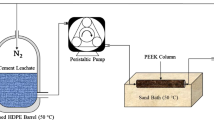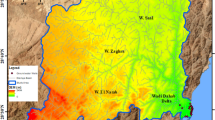Abstract
Characterization of aquifers contaminated by petroleum hydrocarbons is limited by the use of dissolution mass transfer correlations developed for single compounds without considering the effects of the mass transfer limitations in presence of other components. A one-dimensional implicit numerical model is developed for the coupled mass transfer and transport processes and the results are analysed using existing mass transfer correlations for better understanding of the single and multicomponent dissolution processes. The mass transfer coefficient in the multicomponent system is found to be more nonlinear and extending with changing slope, unlike the exponential reduction for single compound system. During the initial phase, the dissolution rate of a soluble compound is very high due to the high concentration gradient, and as dissolution progresses, its effective solubility decreases with change in mole fraction. At higher pore volumes, the mole fractions of lower solubility fractions increase which can result in higher effective solubility. The kinetics of interphase mass transfer by dissolution and sorption is favoured by coupled biodegradation. However, mass transfer limitation for more soluble compounds under the conditions of low residual saturation and low mole fraction is observed to be due to low dissolution rate coefficient rather than decreasing concentration gradient.









Similar content being viewed by others
References
Abriola L M 1989 Modeling multiphase migration of organic chemicals in groundwater systems-a review and assessment. Environ. Health Persp. 83: 117–143
Alvarez P J J, Anid P J and Vogel T M 1991 Kinetics of aerobic biodegradation of benzene and toluene in sandy aquifer material. Biodegrad. 9: 43–51
ASTM 1995 Standard guide for risk-based corrective action at petroleum release sites. Standard E 1739
Bekins B A, Warren E and Godsy E M 1998 A comparison of zero-order, first-order and Monod biotransformation models. Groundwater 36 (2): 261–268
Bielefeldt A R and Stensel H D 1999 Evaluation of biodegradation kinetic testing methods and long term variability in biokinetics for BTEX metabolism. Wat. Res. 33 (3): 733–740
Borden R C and Piwoni M D 1992 Hydrocarbon dissolution and transport: a comparison of equilibrium and kinetic models. J. Contam. Hydrol. 10: 309–323
Brauner J S and Widdowson M A 2001 Numerical simulation of a natural attenuation experiment with a petroleum hydrocarbon NAPL source. Groundwater 39 (6): 939–952
Burke W R 2012 Rate limited diffusion and dissolution of multicomponent non-aqueous phase liquids (NAPLs) in groundwater: Masters Dissertation, University of Alabama
Carroll K C and Brusseau M L 2009 Dissolution, cyclodextrin-enhanced solubilization and mass removal of an ideal multicomponent organic liquid. J. Contam. Hydrol. 106(1–2): 62–72
Chamkha A J 2007 Numerical Modeling of Contaminant Transport with Spatially-Dependent Dispersion and Non-Linear Chemical Reaction. Nonlinear Anal: Model. Control. 12(3): 329–343
Chu M, Kitanidis P K and McCarty P L 2007 Dependence of lumped mass transfer coefficient on scale and reactions kinetics for biologically enhanced NAPL dissolution. Adv. Water Resour. 30: 1618–1629
Clement T P, Sun Y, Hooker B S and Petersen J N 1998 Modeling multi-species reactive transport in groundwater. GWMR- spring: 79–92
Clement T P, Guatam T R, Lee K K, Truex M J and Davis G B 2004 Modeling of DNAPL dissolution, rate-limited sorption and biodegradation reactions in groundwater systems. Bioremed. J. 9(1–2): 47–64
Corapcioglu M Y, Yoon S and Chowdhury S 2009 Pore-scale analysis of NAPL blob dissolution and mobilization in porous media. Trans. Porous Med. 79: 419–442
Couto P R L and Malta S M C 2008 Interaction between sorption and biodegradation processes in contaminant transport. Eco. Model. 214: 65–73
Diplock E E, Mardlin D P, Killhama K S and Paton G I 2009 Predicting bioremediation of hydrocarbons: Laboratory to field scale. J. Environ. Pollu. 157: 1831–1840
Essaid I E, Cozzarellib I M, Eganhouseb R P, Herkelratha W N, Bekinsa B A and Delin G N 2003 Inverse modeling of BTEX dissolution and biodegradation at the Bemidji, MN crude-oil spill site. J. Contam. Hydrol. 67: 269–299
Feenstra S 1997 Aqueous Concentration Ratios to Estimate Mass of Multicomponent NAPL Residual in Porous Media. Doctoral Dissertation. Canada: University of Waterloo
Frind E O, Molson J W and Schiemer M 1999 Dissolution and mass transfer of multiple organics under field conditions: The Borden emplaced source. Water Resour. Res. 35(3): 683–694
Garg S and Rixey W G 1999 The dissolution of benzene, toluene, m-xylene and naphthalene from a residually trapped non-aqueous phase liquid under mass transfer limited conditions. J. Contam. Hydrol. 36: 313–331
Geller J T and Hunt J R 1993 Mass transfer from non-aqueous phase organic liquids in water-saturated porous media. Water Resour. Res. 29(4): 833–845
Gonullu M T 1996 Modeling dissolution of an organic mixture in the subsurface. Water Res., 30(3): 649–653
Grant G P and Gerhard J I 2004 Sensitivity of predicted DNAPL source zone longevity to mass transfer correlation model. Geoenviron. Eng: Integr. Manage. Groundwater Contam. Land. R N Young and H R Thomas (eds.), London: Telford Publishing pp. 59–67
Hamed M M, Nelson P D and Bedient P B 2000 A distributed-site model for non-equilibrium dissolution of multicomponent residually trapped NAPL. Environ. Model. Soft. 15: 443–450
Hansen S K 2012 Coupled multi-component NAPL dissolution and transport in the subsurface: analytic solutions and forensic aspects. Doctoral dissertation. Canada: Queen’s University
Imhoff P T, Jaffe P R and Pinder G F 1994 An experimental study of complete dissolution of a non-queous phase liquid in saturated porous media. J. Water Resour. Res. 30(2): 307–320
Johnson G R, Zhang Z and Brusseau M L 2003 Characterizing and quantifying the impact of immiscible-liquid dissolution and nonlinear, rate-limited sorption/desorption on low-concentration elution tailing. Water Resour. Res. 39(5): SBH 6(1)–6(8)
Kao C M and Prosser J 2001 Evaluation of natural attenuation at a gasoline spill site. J. Hazard. Mater., B82: 275–289
Keller A A and Sirivithiyapakorn S 2000 Pore Scale Determination of the Rate of NAPL Dissolution or Volatilization. Report (EPA Agreement Number: R826268), University of California, Santa Barbara [ http://www.bren.ucsb.edu/~keller/default.html#Projects]
Kim S, Hwang I, Kim D, Lee S and Jury W A 2003 Effect of sorption on benzene biodegradation in sandy soil. Environ. Toxic.Chem. 22(10): 2306–2311
Kim T J and Chrysikopoulos C V 1999 Mass transfer correlations for non-aqueous phase liquid pool dissolution in saturated porous media. Water Resour. Res. 35: 449–459
Liu L, Tindall J A, Friedel M J and Zhang W 2007 Biodegradation of Organic Chemicals in Soil/Water Microcosms System: Model Development. Water Air Soil Pollut. 178: 131–143
Lovanh N, Zhang Y K, Heathcote R C and Alvarez P J J 2000 Guidelines to Determine Site-Specific Parameters for Modeling the Fate and Transport of Mono-aromatic Hydrocarbons in Groundwater. Report submitted to Iowa Comprehensive Petroleum Underground Storage Tank Fund Board. [ http://www.iowadnr.gov/portals/idnr/uploads/ust/monohydrocarbonsguide.pdf]
Maliyekkal S M, Rene E R, Philip L and Swaminathan T 2004 Performance of BTX degraders under substrate versatility conditions. J. Haz. Mater. B109: 201–211
Mayer A S and Miller C T 1996 The influence of mass transfer characteristics and porous media heterogeneity on non aqueous phase dissolution. Water Resour. Res. 32(6): 1551–1568
McCray J E and Dugan P J 2002 Non-ideal equilibrium dissolution of trichloroethene from a decane-based non-aqueous phase liquid mixture: Experimental and modeling investigation. Water Resour. Res. 38(7): 1–9
Miller C T, Poirier-McNeill M M and Mayer A S 1990 Dissolution of trapped non-aqueous phase liquids: Mass transfer characteristics. Water Resour. Res. 26: 2783–2796
Mobile M A, Widdowson M A and Gallagher D L 2012 Multicomponent NAPL Source Dissolution: Evaluation of Mass-Transfer Coefficients. Environ. Sci. Technol 46: 10,047–10,054
Molson J W 2000 Numerical simulation of hydrocarbon fuel dissolution and biodegradation in groundwater. Doctoral Dissertation. Canada: University of Waterloo
Nambi I M and Powers S E 2000 NAPL dissolution in heterogeneous systems: an experimental investigation in a simple heterogeneous system. J. Contam. Hydrol. 44: 161–184
Nambi I M and Powers S E 2003 Mass transfer correlations for non aqueous phase liquid dissolution from regions with high initial saturations. Water Resour.Res. 39(2): SBH 4, 1–11
Natarajan N and Suresh Kumar G 2010 Radionuclide and colloid co-transport in a coupled fracture-skin-matrix system. Colloids Surf. A Physicochem. Eng. Asp. 370: 49–57
Powers S E, Abriola L M and Weber W J 1994 An experimental investigation of non-aqueous phase liquid dissolution in saturated subsurface systems: Transient mass transfer rates. Water Resour. Res. 30(2): 321–332
Prakash P and Nambi I M 2012 Dissolution and contaminant transport in aquifers with spatially and temporally variable hydraulic properties. Special Top. Rev. Porous Med- Int. J. 3(4): 353–369
Priya V S and Philip L 2013 Bioremediation of dichloromethane along with other VOCs from pharmaceutical wastewater. Appl. Biochem. Biotechnol. doi: 10.1007/s12010-012-0005-1
Prommer H, Davis G B and Barry D A 2000 Biogeochemical transport modeling of natural and enhanced remediation processes in aquifers. J. Land Contam. Reclam. 8(3): 217–223
Renu V and Suresh Kumar G 2012 Numerical Modeling and Spatial Moment Analysis of Solute Mobility and Spreading in a Coupled Fracture-Skin-Matrix System. Geotech. Geol. Eng. 30(6): 1289–1302
Saba T and Illangasekare T H 2000 Effect of groundwater flow dimensionality on mass transfer from entrapped non-aqueous phase liquid contaminants. Water Resourc. Res. 36(4): 971–979
Schaerlaekens J., Venderborght J, Merckx R and Feyen J 2000 Surfactant enhanced solubilization of residual trichloroethene: An experimental and numerical analysis. J. Contam. Hydrol. 46: 1–16
Seagren E A, Rittmann B E and Valocchi A J 1999 A critical evaluation of the local-equilibrium assumption in modeling NAPL-pool dissolution. J. Contam. Hydrol. 39: 109–135
Sekhar M and Suresh Kumar G 2006 Modeling transport of linearly sorbing solutes in a single fracture: Asymptotic behavior of solute velocity and dispersivity. Geotech. Geol. Eng. 24: 183–201
Sekhar M, Suresh Kumar G and Mishra D 2006 Numerical modeling and analysis of solute velocity and macrodispersion for linearly and nonlinearly sorbing solutes in a single fracture with matrix diffusion. J. Hydrol. Eng. 11(4): 319–328
Soga K, Page J W E and Illangasekare T H 2004 A review of NAPL source zone remediation efficiency and the mass flux approach. J. Hazard. Mater. 110: 13–27
Sulaymon A H and Gzar H A 2011 Experimental investigation and numerical modeling of light non-aqueous phase liquid dissolution and transport in a saturated zone of the soil. J. Hazard. Mater. 186: 1601–1614
Suresh Kumar G 2008 Effect of Sorption Intensities on Dispersivity and Macro-dispersion Coefficient in a Single Fracture with Matrix Diffusion. Hydrogeol. J. 16: 235–249
Suresh Kumar G 2009 Influence of Sorption Intensity on Solute Mobility in a Fractured Formation. J. Environ. Eng., 135(1): 1–7
Suresh Kumar G 2014 Mathematical Modeling of Groundwater Flow and Solute Transport in a Saturated Fractured Rock using Dual-Porosity Approach. J. Hydrol. Eng. doi:10.1061/(ASCE)HE.1943-5584.0000986
Suresh Kumar G, Sekhar M and Misra D 2008 Time-dependent dispersivity of linearly sorbing solutes in a single fracture with matrix diffusion. J. Hydrol. Eng. 13(4): 250–257
Ucankus T and Unlu K 2008 The effect of aquifer heterogeneity on natural attenuation rate of BTEX. J. Environ Geol. 54: 759–776
Vasudevan M, Suresh Kumar G and Nambi I M 2012 Effect of rate limited dissolution and sorption on concentration tailing of multi-component petroleum hydrocarbons from residual sources. Int. J. Earth Sci. Eng. 5, 6(1): 1750–1756
Wang X 2004 A multi-scale study of dissolution, sorption, and biodegradation of a NAPL mixture. Master’s dissertation. Canada: University of Toronto
Yadav B K and Hassanizadeh S M 2011 An overview of biodegradation of LNAPLs in coastal (semi)-arid environment. Water Air Soil Pollut. 220 (1–4): 225–239
Yang X, Erickson L E and Fan L T 1995 A study of the dissolution rate-limited biodegradation of soils contaminated by residual hydrocarbons. J. Hazard. Mater. 41: 299–313
Zhang Z and Brusseau M L 2004 Non-ideal transport of reactive contaminants in heterogeneous porous media: 7. distributed-domain model incorporating immiscible-liquid dissolution and rate-limited sorption/desorption. J. Contam. Hydrol. 74: 83–103
Acknowledgements
The first author would like to thank Mr. M Berlin and Dr. N Natarajan for the help during this study.
Author information
Authors and Affiliations
Corresponding author
Rights and permissions
About this article
Cite this article
VASUDEVAN, M., SURESH KUMAR, G. & NAMBI, I.M. Numerical modelling of multicomponent LNAPL dissolution kinetics at residual saturation in a saturated subsurface system. Sadhana 39, 1387–1408 (2014). https://doi.org/10.1007/s12046-014-0282-1
Received:
Revised:
Accepted:
Published:
Issue Date:
DOI: https://doi.org/10.1007/s12046-014-0282-1




